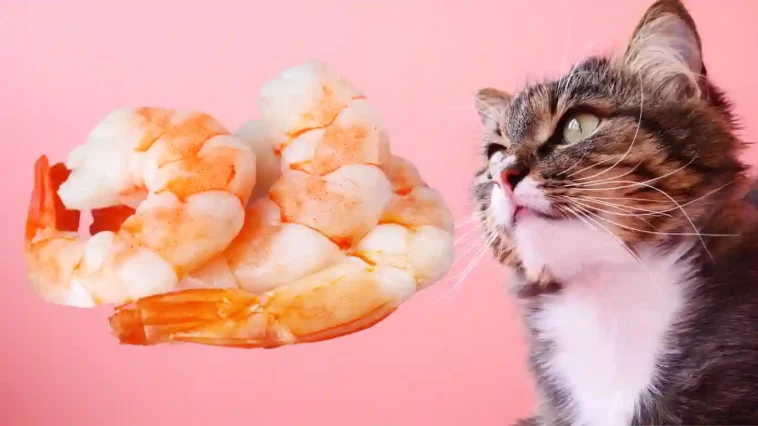You’re peeling shrimp in the kitchen, and suddenly—there’s your cat. Eyes wide, tail flicking, nose twitching. That seafood scent seems to cast a spell, and now they’re staring at you like you’ve just opened a portal to heaven. You wonder, “Can cats eat shrimp?” And maybe more importantly—should they?
Let’s break it down and see if this seafood snack is a safe treat or something to keep out of paw’s reach.
Is Shrimp Safe for Cats?
Cats can eat shrimp in small amounts and under the right conditions.
Shrimp isn’t toxic to cats. It’s often found in some commercial cat foods and treats. It’s high in protein, low in calories, and full of flavor that most cats go wild for. But as with any human food, how it’s prepared—and how much is given—matters more than anything else.
Just because shrimp is safe doesn’t mean it should become a daily snack. Think of it like dessert: fine occasionally, but not something your cat should fill up on.
Is Shrimp Good for Cats?
Shrimp does offer some health benefits. It’s rich in:
- Lean protein
- Vitamin B12
- Phosphorus
- Selenium
- Omega-3 fatty acids
These nutrients support muscle development, immune function, and a shiny coat. But keep in mind that cats are obligate carnivores. They get all the essential nutrients they need from a balanced meat-based diet.
So, while a little shrimp can be a fun reward, it shouldn’t replace proper cat food. It’s a treat—not a meal.
Can Cats Eat Raw Shrimp?
Technically, yes. But should they? Not really.
Raw shrimp can contain harmful bacteria like Listeria or Salmonella, which can cause digestive upset or even more serious illness in cats. Their stomachs are more acidic than ours, but that doesn’t make them immune to food poisoning.
If you wouldn’t eat raw shrimp from your fridge or a questionable market, don’t let your cat do it.
Cooked shrimp is always the safer option.
Can Cats Eat Cooked Shrimp?
Yes—cooked shrimp is the best and safest way to share this treat with your cat.
Here’s how to prepare it:
- Boiled or steamed only
- No seasonings (no garlic, onion, butter, salt, or pepper)
- Cool it down completely before serving
- Chop into small pieces if it’s a larger shrimp
Never give them fried, spicy, or heavily flavored shrimp. What tastes good to us could be irritating—or even dangerous—to a cat’s stomach.
Can Cats Eat Shrimp Tails?
Shrimp tails are technically edible but can be a choking hazard, especially for kittens or smaller cats.
They’re sharp and harsh and can irritate your cat’s digestive tract. Imagine trying to digest something like a plastic chip—that’s kind of what a tail is like to a cat.
If you’re sharing shrimp with your feline, remove the tail first.
Can Cats Eat Shrimp Shells?
This one’s a little tricky.
Some cats love chewing on shrimp shells, and while the shell isn’t toxic, it’s not exactly safe either. The texture is rough, and if the shell isn’t cooked well or is too large, it can:
- Get stuck in their throat
- Cause stomach irritation
- Damage their gums or teeth
If you offer any shell, it should be fully cooked, very soft, and in tiny pieces. But really, it’s best to skip it altogether.
Can Cats Eat Shrimp Cocktail?
That depends. Are you talking about the shrimp—or the cocktail sauce?
The shrimp itself (if plain and properly cooked) is delicate. But the cocktail sauce? That’s a hard no. It contains garlic, onion, salt, sugar, and sometimes even horseradish—all bad for cats and can cause serious issues.
If you’re enjoying a shrimp cocktail at a party, sneak your cat a plain piece—no sauce, spice, or risk.
Can Cats Eat Fried Shrimp?
Fried shrimp smells delicious, and your cat probably thinks so, too. But fried foods are a no-go for feline stomachs.
The batter often includes garlic, onion, salt, and spices. The frying oil is hard on your cat’s digestive system and can lead to vomiting, diarrhea, or pancreatitis.
Skip the fried shrimp. Could you give them a boiled version instead?
How Much Shrimp Can a Cat Have?
A good rule of thumb? Think treat-sized.
- For an adult cat: 1–2 small, plain shrimp per week
- For a kitten: half a shrimp, chopped into bits
Shrimp should be no more than 10% of your cat’s weekly food intake. Any more than that, you risk upsetting their regular meals’ nutritional balance.
Best Ways to Feed Shrimp to Cats
Here are some fun, safe ways to offer shrimp to your cat:
- Chopped and added as a topper on their usual wet food
- Hand-fed as a training treat (great for bonding)
- Frozen in a DIY cat popsicle with water or broth
- Mixed with pumpkin for a fiber-rich treat
Whatever you choose, always supervise the first few times you offer shrimp. Cats, like people, can have individual food sensitivities.
Watch Out for These Warning Signs
If your cat tries shrimp and shows any of these symptoms, stop immediately and call your vet:
- Vomiting or diarrhea
- Itching or swelling around the face or mouth
- Excessive drooling
- Trouble breathing
These could be signs of an allergy or digestive reaction. Shrimp is generally safe—but no treat is worth a health scare.
Safe Seafood Alternatives
If your cat loves seafood, you can also try:
- Canned tuna in water (occasional treat only!)
- Salmon (plain, cooked)
- Sardines (low sodium, in water)
- Commercial seafood-flavored cat treats
Just make sure all seafood is boneless, plain, and served in moderation.
FAQs
Can cats eat raw shrimp?
They can, but it’s risky due to bacteria like Salmonella. Always cook shrimp before giving it to your cat.
Can cats eat shrimp tails?
It’s not recommended. Shrimp tails can be sharp and cause choking or digestive issues.
Can cats eat cooked shrimp?
Yes! Cooked shrimp—plain, unseasoned, and chopped—is safe and even healthy in moderation.
Can cats eat shrimp shells?
Not really. They’re hard to chew and digest and can cause internal damage or choking. Better to leave them out.
Can cats eat shrimp cocktails?
Only the shrimp part—never the sauce. Cocktail sauce contains ingredients that are harmful to cats.
Can cats eat fried shrimp?
No. Fried foods are greasy and can upset your cat’s stomach. Stick to steamed or boiled shrimp instead.
Final Thoughts: Shrimp Isn’t Just for You—But Share with Care
If your cat begs for a piece of shrimp, go ahead and share—just keep it clean, simple, and small.
Shrimp can be a delicious treat packed with protein and flavor that cats adore. But too much of a good thing (or the wrong preparation) can do more harm than good. So, skip the tails, toss the sauce, and serve it plain and cooked.
It’s one more little way to say, “I love you”—without saying a word. After all, nothing beats that happy purr when your cat gets a taste of something special (and safe) from your plate.





GIPHY App Key not set. Please check settings